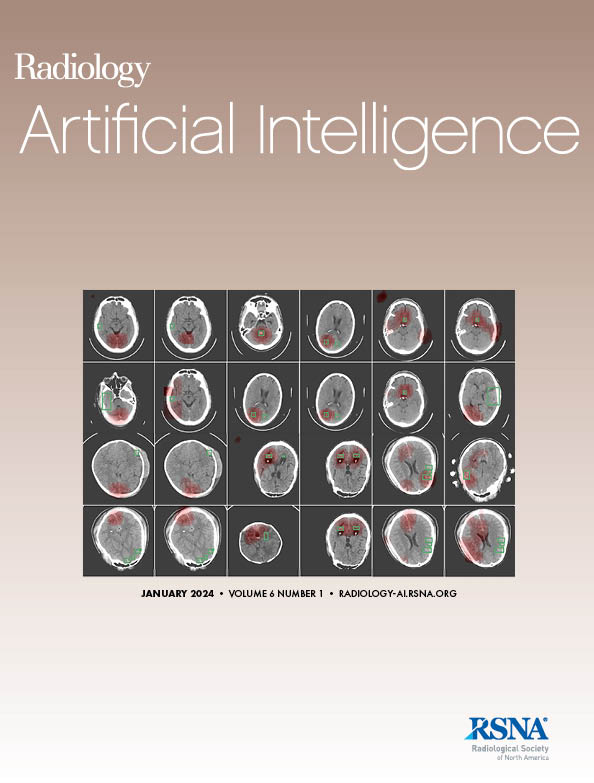求助PDF
{"title":"三维医学图像分割的训练后网络压缩:通过Tucker分解减少计算量。","authors":"Tobias Weber, Jakob Dexl, David Rügamer, Michael Ingrisch","doi":"10.1148/ryai.240353","DOIUrl":null,"url":null,"abstract":"<p><p>Purpose To investigate whether the computational effort of three-dimensional CT-based multiorgan segmentation with TotalSegmentator can be reduced via Tucker decomposition-based network compression. Materials and Methods In this retrospective study, Tucker decomposition was applied to the convolutional kernels of the TotalSegmentator model, an nnU-Net model trained on a comprehensive CT dataset for automatic segmentation of 117 anatomic structures. The proposed approach reduced the floating-point operations and memory required during inference, offering an adjustable trade-off between computational efficiency and segmentation quality. This study used the publicly available TotalSegmentator dataset containing 1228 segmented CT scans and a test subset of 89 CT scans and used various downsampling factors to explore the relationship between model size, inference speed, and segmentation accuracy. Segmentation performance was evaluated using the Dice score. Results The application of Tucker decomposition to the TotalSegmentator model substantially reduced the model parameters and floating-point operations across various compression ratios, with limited loss in segmentation accuracy. Up to 88.17% of the model's parameters were removed, with no evidence of differences in performance compared with the original model for 113 of 117 classes after fine-tuning. Practical benefits varied across different graphics processing unit architectures, with more distinct speedups on less powerful hardware. Conclusion The study demonstrated that post hoc network compression via Tucker decomposition presents a viable strategy for reducing the computational demand of medical image segmentation models without substantially impacting model accuracy. <b>Keywords:</b> Deep Learning, Segmentation, Network Compression, Convolution, Tucker Decomposition <i>Supplemental material is available for this article</i>. © RSNA, 2025.</p>","PeriodicalId":29787,"journal":{"name":"Radiology-Artificial Intelligence","volume":" ","pages":"e240353"},"PeriodicalIF":13.2000,"publicationDate":"2025-03-01","publicationTypes":"Journal Article","fieldsOfStudy":null,"isOpenAccess":false,"openAccessPdf":"","citationCount":"0","resultStr":"{\"title\":\"Post-Training Network Compression for 3D Medical Image Segmentation: Reducing Computational Efforts via Tucker Decomposition.\",\"authors\":\"Tobias Weber, Jakob Dexl, David Rügamer, Michael Ingrisch\",\"doi\":\"10.1148/ryai.240353\",\"DOIUrl\":null,\"url\":null,\"abstract\":\"<p><p>Purpose To investigate whether the computational effort of three-dimensional CT-based multiorgan segmentation with TotalSegmentator can be reduced via Tucker decomposition-based network compression. Materials and Methods In this retrospective study, Tucker decomposition was applied to the convolutional kernels of the TotalSegmentator model, an nnU-Net model trained on a comprehensive CT dataset for automatic segmentation of 117 anatomic structures. The proposed approach reduced the floating-point operations and memory required during inference, offering an adjustable trade-off between computational efficiency and segmentation quality. This study used the publicly available TotalSegmentator dataset containing 1228 segmented CT scans and a test subset of 89 CT scans and used various downsampling factors to explore the relationship between model size, inference speed, and segmentation accuracy. Segmentation performance was evaluated using the Dice score. Results The application of Tucker decomposition to the TotalSegmentator model substantially reduced the model parameters and floating-point operations across various compression ratios, with limited loss in segmentation accuracy. Up to 88.17% of the model's parameters were removed, with no evidence of differences in performance compared with the original model for 113 of 117 classes after fine-tuning. Practical benefits varied across different graphics processing unit architectures, with more distinct speedups on less powerful hardware. Conclusion The study demonstrated that post hoc network compression via Tucker decomposition presents a viable strategy for reducing the computational demand of medical image segmentation models without substantially impacting model accuracy. <b>Keywords:</b> Deep Learning, Segmentation, Network Compression, Convolution, Tucker Decomposition <i>Supplemental material is available for this article</i>. © RSNA, 2025.</p>\",\"PeriodicalId\":29787,\"journal\":{\"name\":\"Radiology-Artificial Intelligence\",\"volume\":\" \",\"pages\":\"e240353\"},\"PeriodicalIF\":13.2000,\"publicationDate\":\"2025-03-01\",\"publicationTypes\":\"Journal Article\",\"fieldsOfStudy\":null,\"isOpenAccess\":false,\"openAccessPdf\":\"\",\"citationCount\":\"0\",\"resultStr\":null,\"platform\":\"Semanticscholar\",\"paperid\":null,\"PeriodicalName\":\"Radiology-Artificial Intelligence\",\"FirstCategoryId\":\"1085\",\"ListUrlMain\":\"https://doi.org/10.1148/ryai.240353\",\"RegionNum\":0,\"RegionCategory\":null,\"ArticlePicture\":[],\"TitleCN\":null,\"AbstractTextCN\":null,\"PMCID\":null,\"EPubDate\":\"\",\"PubModel\":\"\",\"JCR\":\"Q1\",\"JCRName\":\"COMPUTER SCIENCE, ARTIFICIAL INTELLIGENCE\",\"Score\":null,\"Total\":0}","platform":"Semanticscholar","paperid":null,"PeriodicalName":"Radiology-Artificial Intelligence","FirstCategoryId":"1085","ListUrlMain":"https://doi.org/10.1148/ryai.240353","RegionNum":0,"RegionCategory":null,"ArticlePicture":[],"TitleCN":null,"AbstractTextCN":null,"PMCID":null,"EPubDate":"","PubModel":"","JCR":"Q1","JCRName":"COMPUTER SCIENCE, ARTIFICIAL INTELLIGENCE","Score":null,"Total":0}
引用次数: 0
引用
批量引用

 求助内容:
求助内容: 应助结果提醒方式:
应助结果提醒方式:


